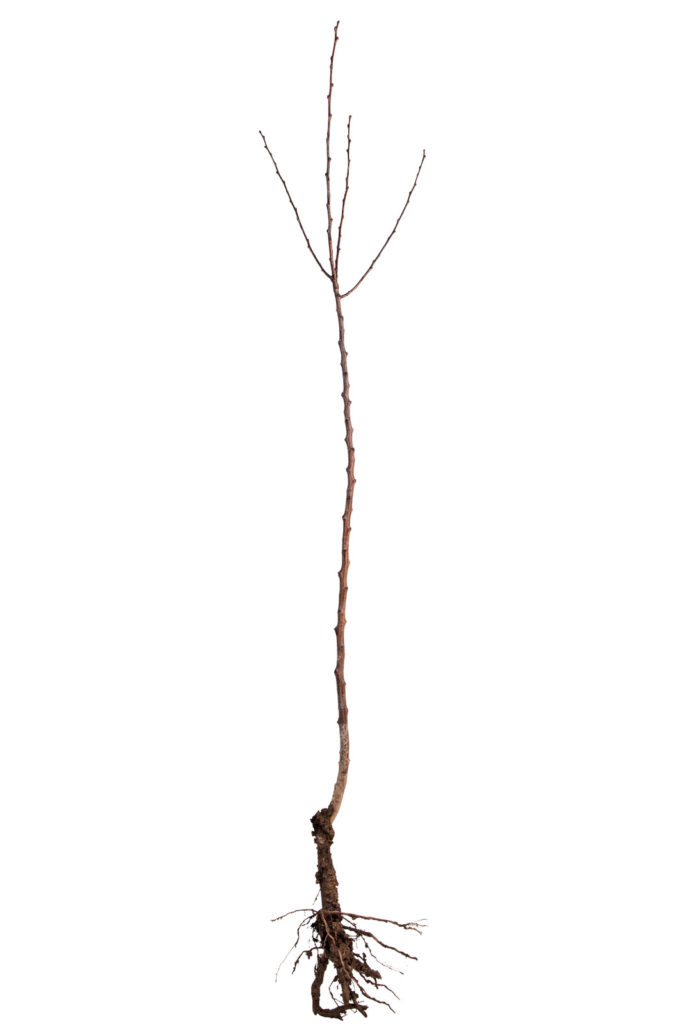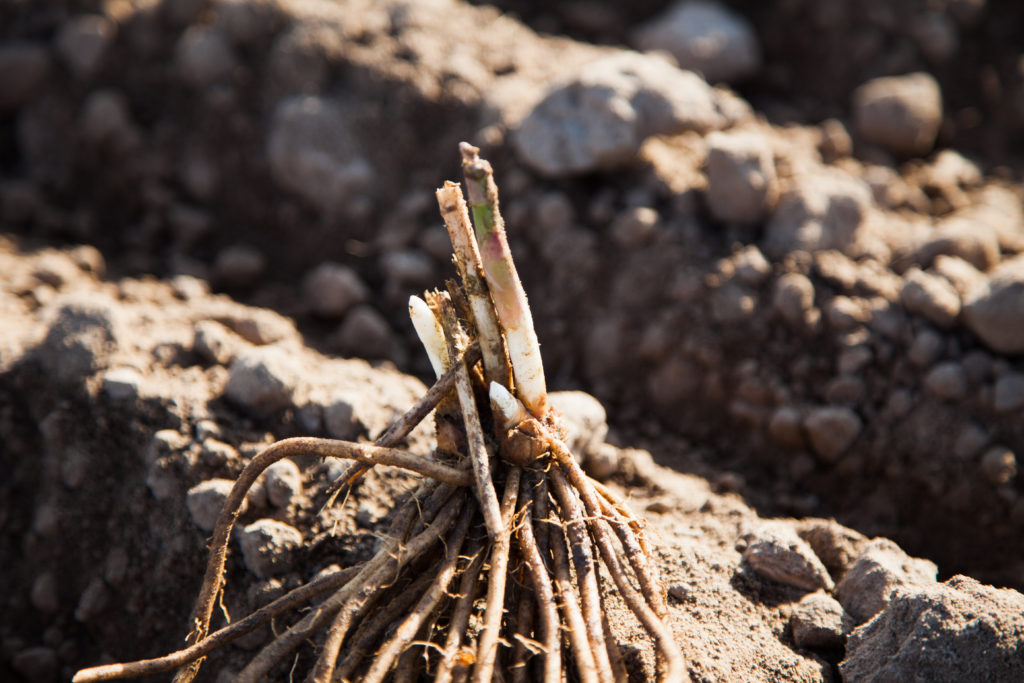Bare root trees and shrubs are deciduous plants that are sold and planted without soil around their roots. Bare root plants are sold and planted during the time of the year when deciduous plants are dormant, usually winter and early spring. To survive bare roots must be planted before they break dormancy and begin to leaf out.
The roots of bare root plants are commonly wrapped in damp material such as sawdust which can be kept moist during transport and planting. Bare roots are less expensive than containerized plants because they can be shipped without soil surrounding their roots.

How to buy bare root fruit trees and berries
To buy bare root fruit trees and berries, you can follow these steps:
Research the plant
Research and decide on the type of fruit tree or berry bush you want to purchase. Consider factors like climate compatibility, soil conditions, sunlight requirements, and space availability. Determine the specific type of fruit trees and berries you want to buy. Consider factors like climate suitability, size, flavor, and care requirements. When buying bare root fruit trees, consider taste, size, disease resistance, and pollination requirements if applicable. Select the varieties that suit your preferences and growing conditions.
Buy from a reputalbe seller
Find a reputable nursery or garden center that specializes in selling bare root plants. You can search online, browse local directories, or ask for recommendations from fellow gardeners or agricultural experts. Read customer reviews and check their reputation for quality plants and reliable service.
Visit a garden center
Visit the nursery or garden center in person, if possible, to see the available selection of bare plants such as bare root fruit trees and berries. This will allow you to inspect the plants and select the healthiest ones. Alternatively, you can also order bare root plants online, but be sure to choose a trusted supplier.
Consult with nursery staff
Consult with the nursery staff or read product descriptions to gather information about the specific variety of fruit tree or berry plant you are interested in. Inquire about their growth habits, pollinator requirements, recommended planting techniques, and any other relevant details. Bare root fruit trees and berries are typically available for purchase during the dormant season, which is typically in late fall or winter. Check with the nursery or gardening center for the specific timing in your area.
Preorder if possible
Many nurseries offer preorders for bare root fruit trees and berries. Popular plant varietiees often sell out when offered as bare roots; the lower price of bare root plants can attract many buyers. Check the grower or nursery website or contact the nursery to inquire about availability and placing an order. Preordering ensures you get the plants you want before they sell out.
Check the quality of the plant
Check the quality of the bare root plants before purchasing. Look for healthy roots that are undamaged, have good color, and are well-developed. Avoid plants with signs of disease, mold, or damage.
Check plant health
When purchasing, select plants with well-formed root systems and no signs of disease or damage. The roots should be moist and have a healthy color.
Check shipping dates
Confirm with the nursery about the shipping date, as bare root fruit trees and berries should ideally be planted during the dormant period. The nursery will package the plants appropriately to keep them moist and protected during transportation.
Place the order
After deciding on the fruit trees and berries you want to buy, place your order online or over the phone. Provide the necessary personal and shipping details. Some nurseries may require an upfront payment while others may allow payment upon delivery.
Double-check sales records
Complete the purchase transaction and make sure you receive a receipt or proof of purchase. If ordering online, double-check that you have entered the correct shipping address and other necessary details.
Tree and shrub buyer’s checklist
Bare-root trees and shrubs
- Look for a strong stem that has been trained vertically.
- Branched trees should have up to a half dozen strong, well-spaced laterals forming wide V-shaped angles with the main stem.
- Avoid trees with long, spindly growth.
- Roots should be healthy and vigorous and radiate from the base of the tree.
- The union should be strong and undamaged.
Container-grown trees and shrubs
- Choose a tree with a straight stem with no sideshoots at the base.
- Look for a healthy root system. Avoid plants that are potbound with roots that coil around the side of the container.
- The potting medium should be moist, not dried out, without weeds or moss growing on the surface.
- If the tree is leafed, look for discolored or distored foliage or any signs of dieback or pests..
- The union should be strong and clean with no signs of splitting or damage.

Planting and caring for bare root plants
Before your bare root fruit trees and berries arrive, prepare the planting site by removing weeds, loosening the soil, and incorporating organic matter like compost. Ensure the site provides adequate sunlight, drainage, and space required for healthy growth.
Once you receive the bare root plants, inspect them again to make sure they are in good condition. Carefully unpack them and inspect the plants for any signs of damage or disease. If any issues arise, contact the nursery or supplier immediately. When the bare root fruit trees and berries arrive,
Be sure you have the necessary planting material, such as adequate soil, organic matter, fertilizer, and mulch. Follow the specific planting instructions provided by the nursery or consult a gardening guide if needed.
It’s essential to plant the bare root trees and berries promptly. Soak the roots in water for a few hours before planting. Before planting, soak the bare roots of the fruit trees or berries in water for a few hours or overnight to rehydrate them. Dig a hole wide and deep enough to accommodate the roots, ensuring the soil is well-drained. Place the plant in the hole, keeping the roots spread out, and backfill the soil, gently firming it around the roots. Water thoroughly after planting.
Follow the recommended planting guidelines, which may involve digging a hole large enough for the roots, spreading them out, and covering them with soil. Generally, dig a hole wide enough to accommodate the roots without bending or crowding them. Gently spread out the roots and backfill with soil, ensuring the crown is level with the soil surface. Avoid planting too deep or burying the graft union of fruit trees.
After planting, water the bare root plants thoroughly and regularly, especially during the first year. Water the newly planted bare root plants thoroughly, and continue to provide sufficient moisture as needed according to their specific watering requirements. Follow the care instructions provided by the nursery or gardening guide to ensure proper watering, fertilizing, and pruning of your fruit trees and berries. Regularly monitor their health and address any issues promptly.
Maintain proper care of the fruit trees or berries, including regular watering, fertilizing, pruning, and protecting them from pests and diseases.
Remember that growing fruit trees and berries requires patience and care. It may take a few years before you can enjoy a bountiful harvest, but the rewards are well worth the effort.

Bare root shopping list
- Fruit trees
- Berries
- Ornamental trees
- Shrubs
- Perennials
Related articles:
Planting Bare Root Trees and Vines
Planning the Home Fruit Garden
Home Fruit Garden Maintenance Calendar



